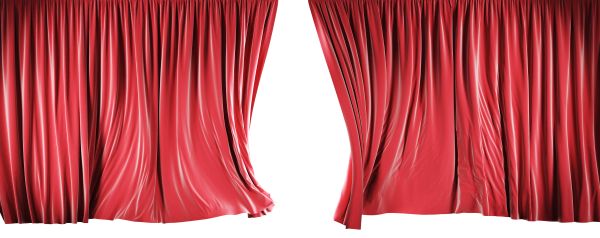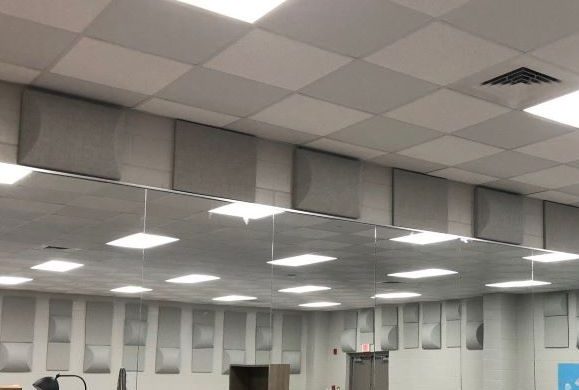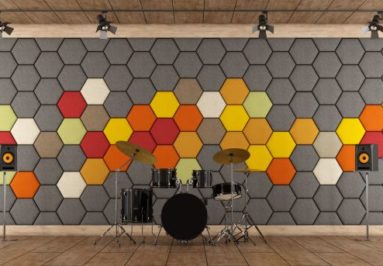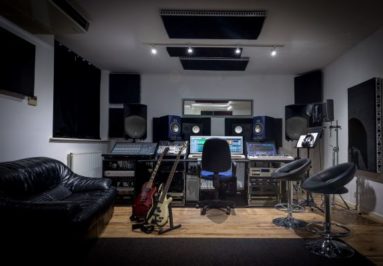You may have heard the terms “echo & reverberation” before, and you may even use the two words interchangeably. Echo and reverberation are actually two different things, but both are created by an initial impulse noise such as a clap, conversation, or music. Both echo and reverb can also be reduced using acoustic treatment such as acoustic panels. Throughout the rest of this article we’ll explain the different between echo and reverberation, and recommend products to reduce the two.
Learn More: Target Reverberation Times Based on Room Use
What’s the Difference Between Echo and Reverberation?

Echo can be defined as a weak reflection of an original sound. If you are in a cave, for example, and you yell “hello,” the sound wave created will hit the cave’s walls and reflect back to you. If more than one second passes before the reflected sound returns to you, you will perceive the original sound and the reflected sound separately. The reflected sound is referred to as the echo.
Reverberation is a little bit different. If the sound wave created takes less than one second to return to you, if the cave is small and the walls are very close to you, for example, then the new sound wave and the original sound wave will combine and you will not be able to perceive any difference between the two. Instead, you will hear them in unison as one, long, drawn-out sound, called a reverberation.
Reverberation Time Explained
The more echo and reverberation that is created in a space, the higher the reverberation time will be. Reverberation time is the amount of time it takes from when an impulse noise is made to when the sound level drops by 60 decibels, and it’s measured in seconds. Depending on the size, finishes and shape of a room, reverberation time can be anywhere between 0.3 and 8 seconds.
Solving Echo and Reverb Problems with Acoustic Panels
While it is impossible to eliminate them entirely, you can greatly reduce the amount of echo and reverberation in a specific location by taking advantage of acoustical solutions. By reducing echo and reverberation with acoustical treatment, you are also decreasing the reverberation time in a room.
- Acoustical absorption panels resolve a wide array of acoustical problems, making them a great product to start with when looking to decrease excessive background noise in noisy environments such as restaurants, offices or auditoriums. As sound waves are created they bounce off of walls, ceilings, floors and any other hard surfaces in a room, creating distracting echo and reverberation. Acoustical absorption panels contain these sound waves and stop them from traveling around the room, drastically decreasing echo and reverberation.
- For a quick fix in critical listening environments such as recording studios or similar venues, acoustical absorption wedge foam can be easily installed directly to walls. This foam will reduce reflected noise from creating echo and reverberation considerably by trapping and dissipating sound waves as they hit.
- For a similar solution to reduce echo and reverberation off of ceilings, try cushion ceiling tiles. This type of ceiling tile is specifically designed to be installed against hard ceiling surfaces in order to absorb sound waves and stop them from bouncing off of the ceiling and creating additional echo and reverberation.
- For further protection in background noise-heavy environments, acoustical diffusers are a favored solution. These diffusers reduce sound intensity by scattering high-frequency sound over a broadened area. They are ideal for places like restaurants, lobbies, and classrooms where background noise can quickly become problematic.
These are just a few of the most common solutions for echo and reverberation issues, but many more exist. Soundproof Direct is dedicated to finding the ideal solution for your specific echo and reverberation problem.
Are there more “traditional” options for Echo and Reverb control?

For basic absorption control, you can also utilize old-school traditional methods of adding sound-absorptive drapes, curtains, or tapestries into your space. This may also include acoustic ceiling tile or heavy carpet on the floor, with a plush carpet pad. While these are just standard materials used in every-day design, they offer a porous surface for sound to be trapped in, reducing (or eliminating altogether) the amount of acoustical absorption needed in the space.
When in doubt, use a tool like the Reverberation Calculator to determine what you current reverberation time is, what your target should be, and how much additional acoustic treatment you need to achieve that target reverb time.





